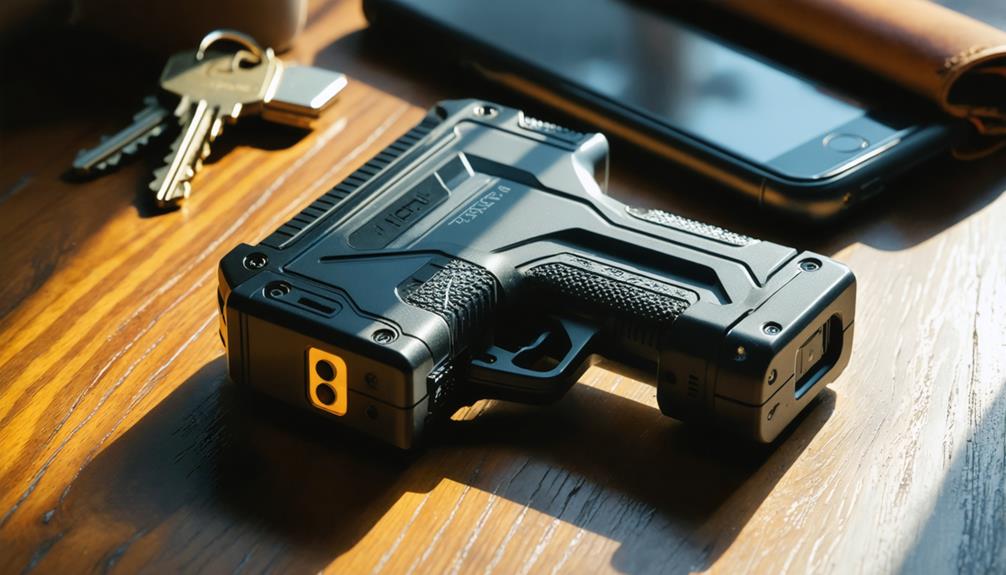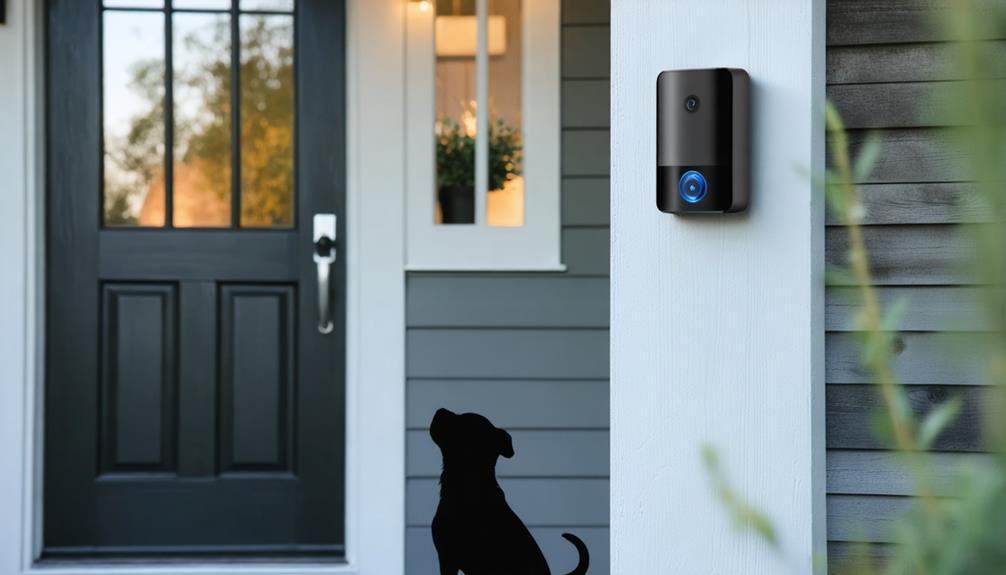
Brainstorm Security Shop

For Orders Over $199

On Any Of Our Products

Details On Refund Page

When you’re considering options for enhancing your home security, a Motion Sensor Barking Dog Alarm might catch your attention. These devices offer an innovative way to deter intruders by mimicking the sound of a barking dog, which can be surprisingly effective. You might wonder how they work, what benefits they provide, and which features are essential for your specific needs. Understanding these aspects could make a significant difference in your security setup. What else should you know before making a decision?
Motion sensor alarms operate by detecting changes in their environment, allowing them to identify movement effectively. You’ll find that these devices utilize advanced sensor technology, which plays a crucial role in their functionality. When someone or something enters the monitored area, the sensors pick up on this movement and trigger the alarm activation process.
Typically, motion sensors work through passive infrared (PIR) technology, which detects heat emitted by people and animals. As you walk by, the sensor notices a change in infrared radiation and activates the alarm. Some systems may also use microwave sensors, which emit microwave pulses to detect movement. The combination of these technologies ensures that the alarm is sensitive enough to detect intruders but not overly sensitive to everyday movements, like a pet wandering.
Once the motion is detected, the alarm system springs into action, emitting a loud sound or alerting you through a connected device. This immediate response helps ensure your safety and can deter potential threats.
Barking dog alarms offer numerous advantages for enhancing home security. First and foremost, they provide significant security benefits. The sound of a barking dog can deter potential intruders, making them think twice before approaching your property. This psychological barrier can be incredibly effective, especially for homes that may not have other security measures in place.
Moreover, these alarms are easy to install and require minimal maintenance, allowing you to focus on enjoying your home rather than constantly worrying about threats. With a barking dog alarm, you can experience peace of mind knowing that your home is being monitored, even when you’re not there.
Additionally, many barking dog alarms can be set to activate only when they detect motion, ensuring that you’re not disturbed by harmless animals or passing pedestrians. This feature enhances the overall effectiveness of the system while maintaining a sense of calm in your environment.
When choosing a barking dog alarm, there are several key features that can significantly impact its effectiveness and usability. One of the most important aspects is alarm customization. You’ll want a system that allows you to adjust the sensitivity levels and the volume of the alarm to suit your specific needs. This flexibility ensures that you can effectively detect intruders while avoiding false alarms triggered by pets or other harmless movements.
Another essential feature is pet-friendly settings. These settings help ensure that your alarm won’t react to your furry friends moving around the house. This is crucial for maintaining a peaceful environment at home, especially if you have multiple pets. A good barking dog alarm should distinguish between a human presence and your pets, allowing for reliable alerts only when necessary.
Additionally, consider the range of the motion sensor. A wider range ensures that the alarm covers more area, enhancing security.
Various types of motion sensor alarms are available, each designed to cater to different security needs and environments. Choosing the right one can significantly enhance alarm effectiveness. Here are three popular types you might consider:
When selecting a motion sensor alarm, consider your living space and security needs. By understanding the types available, you can choose the best fit for your home and ensure your safety without inconveniencing your pets.
When setting up your motion sensor barking dog alarm, choosing the right location is crucial for optimal performance.
You’ll want to use proper wiring techniques to ensure a reliable connection, and testing the sensitivity settings will help fine-tune the system to your environment.
Let’s explore these installation tips and best practices to make the most of your alarm.
Selecting the ideal location for your motion sensor barking dog alarm is crucial for maximizing its effectiveness. The right placement can significantly enhance its ability to detect intruders and alert you promptly. Here are some placement tips to consider:
When choosing ideal locations, think about the areas with high foot traffic or vulnerability. Your alarm should cover as much ground as possible to act as an effective deterrent.
Additionally, avoid placing it near heat sources or direct sunlight, which can interfere with its performance. By following these guidelines, you’ll maximize your motion sensor barking dog alarm’s potential, providing you with peace of mind and improved security.
While ensuring your motion sensor barking dog alarm is installed correctly is essential for optimal performance, proper wiring techniques play a crucial role in this process. Start by consulting the wiring diagram that comes with your alarm. This diagram will guide you through the specific connections needed for your system.
Before you begin, prioritize electrical safety. Always turn off the power supply to the area where you’ll be working. Use insulated tools and wear rubber-soled shoes to further protect yourself from any potential electrical hazards.
When connecting the wires, make sure to strip the insulation carefully, avoiding damage to the copper strands. Twist the wires together securely and use wire nuts to cover them, ensuring no exposed wires are left.
Double-check all connections against the wiring diagram before restoring power to the system. Once everything’s connected, you can proceed to test your alarm. Following these wiring techniques not only ensures a reliable installation but also enhances the safety of your home. With the right approach, you’ll have peace of mind knowing your barking dog alarm is ready to protect your space efficiently.
Testing the sensitivity settings of your motion sensor barking dog alarm is crucial for achieving optimal performance. You want to make sure it detects movement accurately without false alarms. Here are three key steps to guide you:
When it comes to choosing a motion sensor barking dog alarm, understanding the differences between popular models can significantly impact your decision. You’ll find various options on the market, each with unique features and price points. Start by conducting a thorough price comparison; some models might offer similar functionalities but at different costs. This will help you identify what fits your budget while still meeting your needs.
Next, dig into customer reviews. They provide invaluable insights into real-world experiences with each model. You’ll want to look for feedback on sensitivity, reliability, and overall performance. Pay attention to recurring themes in the reviews, like ease of setup or any issues with false alarms.
Some popular models include the Dog Watch and the PetSafe, both known for their durability and effectiveness. Compare their specifications, like range and sound volume, alongside customer feedback to see which one aligns with your expectations.
Ultimately, weighing both price and customer reviews will give you a clearer picture, helping you choose the best motion sensor barking dog alarm for your home.
When considering deterrents, intruder perception plays a crucial role. If they believe an alarm system’s effective, they might think twice before attempting entry. However, the true effectiveness depends on the alarm’s reliability and visibility.
The average lifespan of a barking dog alarm varies but typically lasts 3 to 5 years. Regular maintenance tips, like cleaning sensors, can extend its life. When it fails, consider replacement options for better security.
Barking dog alarms can affect your indoor pets’ behavior. If they’re noise-sensitive, you might need to make adjustments and provide training to help them adapt. Monitor their reactions to ensure a comfortable environment for everyone.
These devices typically offer flexible installation options. You can choose between battery power sources or direct plug-in options. Just keep in mind the noise level, as false alarms can occur, especially with sensitive settings.
Motion sensors typically have a detection range of 20 to 50 feet. To minimize false alarms, adjust sensor sensitivity and follow placement tips, ensuring they’re positioned away from moving objects or direct sunlight.
Brainstorm Security Shop
1867 Caravan Trail
Ste 105
Jacksonville, FL 32216
Call us toll free: (800) 859-5566